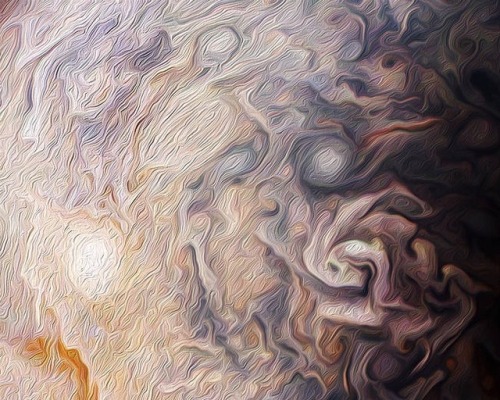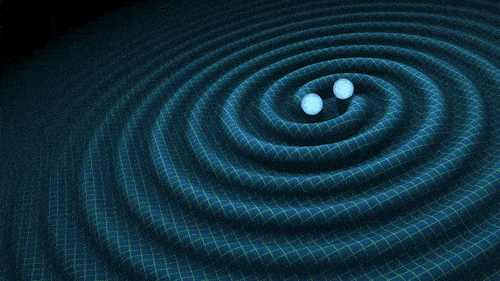Quero Ter Um Desse!
Quero ter um desse!

30 polegadas f/3. Tá bom pra você? Brinquedo de Criança Season 2015.
More Posts from Carlosalberthreis and Others


Citizen scientist Rick Lundh created this abstract Jovian artwork using data from the JunoCam imager on NASA’s Juno spacecraft.
Image credits: NASA/JPL-Caltech/SwRI/MSSS/Rick Lundh
Fazer o bem, faz bem!
Banner da Pastoral Social

What are Gravitational Waves?
Gravitational waves are ‘ripples’ in the fabric of space-time caused by some of the most violent and energetic processes in the Universe. Albert Einstein predicted the existence of gravitational waves in 1916 in his general theory of relativity.

Einstein’s mathematics showed that massive accelerating objects (such as neutron stars or black holes orbiting each other) would disrupt space-time in such a way that ‘waves’ of distorted space would radiate from the source (like the movement of waves away from a stone thrown into a pond). Furthermore, these ripples would travel at the speed of light through the Universe, carrying with them information about their cataclysmic origins, as well as invaluable clues to the nature of gravity itself.
The strongest gravitational waves are produced by catastrophic events such as colliding black holes,

the collapse of stellar cores (supernovae), coalescing neutron stars or white dwarf stars, the slightly wobbly rotation of neutron stars that are not perfect spheres, and the remnants of gravitational radiation created by the birth of the Universe itself.

hough gravitational waves were predicted to exist in 1916, actual proof of their existence wouldn’t arrive until 1974, 20 years after Einstein’s death. In that year, two astronomers working at the Arecibo Radio Observatory in Puerto Rico discovered a binary pulsar–two extremely dense and heavy stars in orbit around each other. This was exactly the type of system that, according to general relativity, should radiate gravitational waves. Knowing that this discovery could be used to test Einstein’s audacious prediction, astronomers began measuring how the period of the stars’ orbits changed over time. After eight years of observations, it was determined that the stars were getting closer to each other at precisely the rate predicted by general relativity. This system has now been monitored for over 40 years and the observed changes in the orbit agree so well with general relativity, there is no doubt that it is emitting gravitational waves.

Since then, many astronomers have studied the timing of pulsar radio emissions and found similar effects, further confirming the existence of gravitational waves. But these confirmations had always come indirectly or mathematically and not through actual 'physical’ contact.
That was the case up until September 14, 2015, when LIGO, for the first time, physically sensed distortions in spacetime itself caused by passing gravitational waves generated by two colliding black holes nearly 1.3 billion light years away! LIGO and its discovery will go down in history as one of the greatest human scientific achievements.

How are gravitational waves detected?
When a gravitational wave passes by Earth, it squeezes and stretches space. LIGO can detect this squeezing and stretching. Each LIGO observatory has two “arms” that are each more than 2 miles (4 kilometers) long. A passing gravitational wave causes the length of the arms to change slightly. The observatory uses lasers, mirrors, and extremely sensitive instruments to detect these tiny changes. Watch the animation below to see how this works!

Lucky for us here on Earth, while the origins of gravitational waves can be extremely violent, by the time the waves reach the Earth they are millions of times smaller and less disruptive. In fact, by the time gravitational waves from the first detection reached LIGO, the amount of space-time wobbling they generated was thousands of times smaller than the nucleus of an atom! Such inconceivably small measurements are what LIGO was designed to make. To find out how LIGO can achieve this task, visit LIGO’s Interferometer.
Source: LIGO & spaceplace.nasa.gov
Image credit: LIGO/VIRGO (SXS, the Simulating eXtreme Spacetimes) & NASA/Goddard Space Flight Center
🌟 🎶 Esse amor não tem fim
Já faz parte de mim
Te amo CAPRICHOSO
E vai ser pra sempre assim
Nasci pra amar você
De azul até morrer
Não há um amor maior
Do amor que eu sinto por você! 🎶 💙
Detectando Ondas Gravitacionais Com a Missão GAIA - Space Today TV Ep.1057
As ondas gravitacionais, para quem ainda não sabe, tem um espectro, assim como a radiação eletromagnética tem o seu.
Esse espectro é chamado de espectro gravitacional.
Dentro do espectro gravitacional, atualmente, com o LIGO e VIRGO nós só conseguimos detectar ondas gravitacionais provenientes da fusão de buracos negros de massa estelar e da fusão de estrelas de nêutrons.
Essas, digamos, são ondas gravitacionais com frequências mais altas.
Mas lógico que existe a ideia e a vontade de se detectar ondas gravitacionais de frequências baixas.
Essas são produzidas, por exemplo, pela colisão de buracos negros supermassivos.
Nós já avançamos um pouco nesse sentido, já que a tecnologia da LISA, um detector espacial nos moldes do LIGO já foi testada e promete funcionar.
Existe também, como já falei aqui a técnica de usar os pulsares, a chamada Pulsar Timing Array.
Essa técnica é interessante, pois ela usa a observação dos pulsares, e calcula a mudança na frequência aparente dos pulsos com relação à passagem de uma onda gravitacional, gerada pela fusão de buracos negros supermassivos, por exemplo.
com base nessa ideia, um grupo de astrofísicos está propondo algo maravilhoso.
Eles querem usar a missão GAIA, da Agência Espacial Europeia, que mede com precisão a posição de bilhões de estrelas na Via Láctea como um detector de ondas gravitacionais de baixa frequência.
Para isso, a ideia é usar não a variação de pulsos dos pulsares, mas sim a aparente modificação na posição das estrelas observadas pela GAIA, ou seja, suas oscilações para detectar as ondas gravitacionais.
A passagem de uma onda gravitacional, que acaba causando uma oscilação no tecido do espaço-tempo, muda a posição das estrelas, a polarização da onda gravitacional pode ser detectada e assim teríamos a detecção de um tipo novo de onda gravitacional.
A vantagem é que a missão GAIA já está em funcionamento no espaço, já faz essas medidas, ou seja, essa aplicação pode ser testada a qualquer momento.
Os astrônomos realmente viram que o estudo das ondas gravitacionais pode trazer muitos novos conhecimentos sobre o universo, e entender os buracos negros supermassivos é algo que os deixa muito animados.
Vamos aguardar por novidades nessa área.

Os cientistas da missão New Horizons da NASA estão aprendendo cada vez mais sobre a estrutura e o comportamento da complexa atmosfera de Plutão, descobrindo novos atributos das suas extensas camadas de névoas. As névoas foram descobertas pela primeira vez quando a sonda New Horizons as fotografou em Julho de 2015.
Os cientistas da missão descobriram que as camadas na atmosfera de nitrogênio de Plutão, variam em brilho dependendo da iluminação e do ponto de vista, embora ela mantenha sua estrutura vertical geral. As variações de brilho podem ocorrer devido as ondas de flutuações, que os cientistas também chamam de ondas de gravidade (e que nada tem a ver com as ondas gravitacionais), que são normalmente lançadas pelo fluxo de ar sobre as cadeias de montanhas. As ondas de gravidade atmosféricas são conhecidas na Terra, em Marte, e agora, provavelmente em Plutão.
As camadas da atmosfera de Plutão são vistas da melhor forma em imagens que foram feitas pela sonda New Horizons quando ela passou atrás do planeta anão. A sonda New Horizons, obteve uma série de imagens retroiluminadas enquanto ela passou por Plutão, no dia 14 de Julho de 2015. Nessas observações feitas pelo instrumento Long Range Reconnaissance Imager, ou LORRI, as camadas atmosféricas sobre localizações específicas em Plutão foram imageadas algumas vezes, num intervalo de 2 a 5 horas. O brilho das camada variam de cerca de 30%, apesar da altura das camadas acima da superfície permanecer a mesma.
Plutão é simplesmente espetacular, quando as primeiras imagens da estrutura da atmosfera foram observadas, elas surpreenderam a todos. O fato de não se ter observado as camadas atmosféricas se movendo para cima e para baixo será importante para os esforços de modelagem no futuro.
Fonte:
https://www.nasa.gov/feature/pluto-s-haze-varies-in-brightness
Science, Technology, Engineering and Math: STEM
Today is College Signing Day and we’re working with the White House to celebrate all graduating seniors and inspire more young people to Reach Higher and enroll in higher education.

Additionally, choosing a degree within a STEM (Science, Math, Engineering and Technology) field enables the United States to remain the global economic and technological leader. We feel that it’s our duty to help inspire the next generation of scientists, technologists, engineers and astronauts.

It’s important that each and every student feels empowered and equipped with the knowledge to solve tough problems, evaluate evidence and analyze information. These are all skills students can learn through studying a subjects in STEM.
College is one of the stepping stones to many careers, including becoming an astronaut! Here are a few of our astronauts on their college graduation day, along with their astronaut portrait.
Astronaut Victor Glover

Undergraduate: California Polytechnic State University Graduate: Air University and Naval Postgraduate School Astronaut Class: 2013
Astronaut Reid Wiseman

Undergraduate: Rensselaer Polytechnic Institute Graduate: Johns hopkins University Astronaut Class: 2009
Astronaut Thomas Marshburn

Undergraduate: Davidson College Graduate: University of Virginia, Wake Forest University and University of Texas medical Branch Astronaut Class: 2004
Astronaut Karen Nyberg

Undergraduate: University of North Dakota Graduate: University of Texas at Austin Astronaut Class: 2000
Astronaut Bob Behnken

Undergraduate: Washington University Graduate: California Institute of Technology Astronaut Class: 2000
Astronaut Peggy Whitson

Undergraduate: Iowa Wesleyan College Graduate: Rice University Astronaut Class: 1996
Astronaut Joseph Acaba

Undergraduate: University of California Graduate: University of Arizona Astronaut Class: 2004
Astronaut Rex Walheim

Undergraduate: University of California, Berkeley Graduate: University of Houston Astronaut Class: 1996
Whether you want to be an astronaut, an engineer or the administrator of NASA, a college education opens a universe of possibilities:
Administrator Charles Bolden

Here, Administrator Bolden wears the jersey of Keenan Reynolds, a scholar athlete who graduates from the Naval Academy this year. His jersey is on its way to the college football hall of fame. Bolden holds a drawing of himself as a midshipman in the Navy.
Deputy Administrator Dava Newman

Deputy Administrator Dava Newman sports her college shirt, along with Lisa Guerra, Technical Assistant to the Associate Administrator. Both women studied aerospace engineering at Notre Dame.
Make sure to follow us on Tumblr for your regular dose of space: http://nasa.tumblr.com

A primeira chuva de meteoros do ano, Quadrantideos, direto de Pocomo Beach.

A Nebulosa da Lagoa, a Trífida e a NGC 6559, os girassóis de Sagittarius. BY NASA APP.
-
 carlosalberthreis reblogged this · 9 years ago
carlosalberthreis reblogged this · 9 years ago -
 astroimages reblogged this · 9 years ago
astroimages reblogged this · 9 years ago
